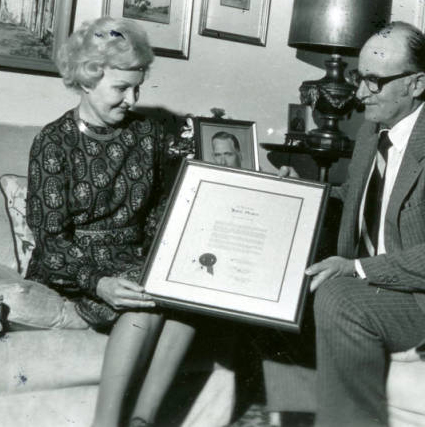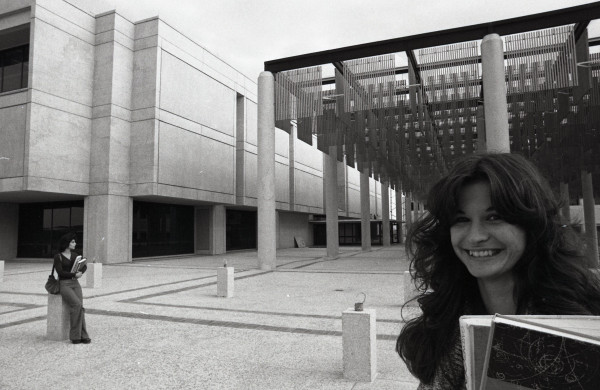History of
UTSA Libraries
"When universities are rated or evaluated, it is on the basis of the quality of faculty and the quality of the library."
- Peter T. Flawn, UTSA President 1973-1978

On Dec. 13, 1974, the University of Texas Board of Regents officially dedicated a library building for UTSA and named it in honor of the late John R. Peace II, an active member of the San Antonio community who championed efforts to bring a four-year public university to San Antonio as a member of the Board of Regents of the UT System. Peace had previously donated his collection of early Texana books and manuscripts to the library in 1973.
San Antonio architect O’Neil Ford designed the building to be a centralized plaza for the university, which at the time was the largest new university under construction in the United States. The library was completed in late 1975 at a total cost of $10,120,489, and it was UTSA’s largest building at 225,891 square feet.
Six weeks prior to the library’s opening, books arrived by the truckload with 4,100 boxes containing 150,000 volumes to be checked in, sorted and shelved for student access. Thirty library employees worked frantically to get all the titles cataloged in Library of Congress sequence.
The John Peace Library (JPL) opened to students on June 2, 1976. It housed 350,000 volumes — 200,000 of them on microfilm — and had study space available to accommodate about 1,300 students. The John Peace Library is still UTSA’s largest library, with four floors containing resources, study spaces, academic support services and a food court.
Milestones

In 1973, before the JPL was constructed, UTSA was designated as a depository for government documents which was an important step in allowing the library to receive free of charge material issued by federal agencies, including scientific and engineering reports and statistical data.
In 1989, the JPL switched from its traditional card catalog to an online computer catalog, making 26 terminals available to users searching for library materials.
Michael Kelly was UTSA’s first director and dean of libraries, serving under four presidents during his 33 year tenure from 1972-2005. He was the guiding force behind the formation of both the John Peace Library and Downtown Library (dedicated in January 1999). Kelly is credited with building the library's initial collections under budget constraints, as well as instituting a student library resource fee that enabled the libraries to add to collections and staff to support the growing university.
Following an interim period where the libraries were led by professor of history David Johnson, Krisellen Maloney was hired as dean in 2009. She led a five-year, multimillion-dollar renovation of the John Peace Library. Collaborating with multiple offices across the university, she oversaw the creation of the Faculty Center to support faculty development; the Learning Commons, a one-stop shop for student academic support; and the Applied Engineering and Technology Library, which is recognized as the nation's first bookless library on a college or university campus. She also bolstered the development of UTSA's Special Collections, which features distinctive research materials documenting the diverse histories and development of San Antonio and South Texas.
Dean Hendrix was hired as UTSA Libraries third dean in 2016.
Top Photo: President Flawn presents a memorial resolution honoring the late John Peace, to his widow, Ruby Peace, December 1974. The resolution was passed by the UTSA faculty on November 22, 1974. The Regents named the John Peace Library on Dec. 13, 1974. Gil Barrera Photographs of the University of Texas at San Antonio, MS 27.
Second Photo: Students Ileana Rodriguez and Sylvana Gennero in front of the John Peace Library, February 1976. Gil Barrera Photographs of the University of Texas at San Antonio, MS 27.
The Downtown Library
The Downtown Library opened in January 1994 in the Downtown Campus’ Cypress Tower. It had one computer, one desk, and one library assistant to help students. The library then moved into a larger, 4,500-square-foot Frio Street library with 10 laptops and study spaces.
In 1999, the Downtown Library moved into its 19,000-square-foot, permeant home on the second floor of the Buena Vista Street Building. The library is surrounded by large windows, making it known for the gorgeous view of the San Antonio skyline among users.
While open to all UTSA students, the Downtown Library primarily supports Downtown majors. It has several study rooms and 80 computers for student use.
Applied Engineering and Technology Library
The Applied Engineering and Technology Library (AET) opened in 2010 under the Libraries’ second dean, Krisellen Maloney, as the nation’s first bookless library on a college or university campus.
The AET Library is open to all students but caters to the College of Sciences and College of Engineering students, and is located in the AET building of UTSA’s Main Campus.
Originally located on the second floor of the AET building, the AET Library moved to the first floor in 2018 to include a lobby area. The bookless library has eight computers for student use that includes engineering software and three group study rooms complete with LCD monitors, large whiteboard and writable glass walls.